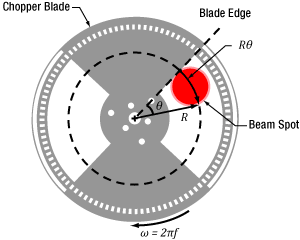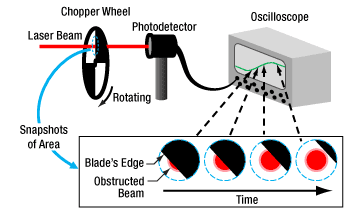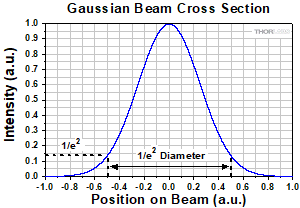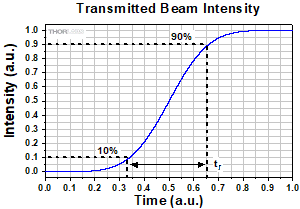チョッパーホイールを使用したビーム径の測定


Please Wait
チョッパーホイールを使用したビームサイズ測定

Click to Enlarge
図2:ブレードは fの角回転速度で、Rθの弧(Rはブレード中心からの距離)をトレースします。図のチョッパーホイールは、MC1F2です。
fの角回転速度で、Rθの弧(Rはブレード中心からの距離)をトレースします。図のチョッパーホイールは、MC1F2です。

Click to Enlarge
図1:上記に示すセットアップでおおよそのビームサイズの測定が可能です。チョッパーホイールのブレードがビームを横切るとき、S字状の曲線がオシロスコープに現れます。

Click to Enlarge
図4:ガウシアンビームの直径は1/e2強度の幅で表されます。

Click to Enlarge
図3:信号の立ち上がり時間(tr )は、通常、強度の10%~90%の時間で定義されます。立ち上がり時間はホイールの回転速度とビーム径に依存します。
カメラや走査スリット型ビームプロファイラはビームサイズやビーム形状を特性化するツールですが、ビームサイズが小さすぎたり、動作範囲外の波長においては正確な測定を行うことができません。
ビームサイズの正確な測定にはチョッパーホイールやフォトディテクタ、オシロスコープが使用されます(図1)。回転するチョッパーホイールがビームを通過すると、S字状の軌跡がオシロスコープに表示されます。
ブレードがθ の角度を掃引すると、S曲線の立ち上がりまたは立ち下がり時間は、ブレードの移動方向に沿ったビームのサイズに比例します(図2)。 ホイールの中心からRの距離にあるブレードエッジ上の点は、ビームサイズにほぼ等しい弧の長さ分(Rθ)、ビームを横切ります。
このビームサイズ測定をするためには、ディテクタとオシロスコープを合わせた応答を、信号の変化の速度よりもはるかに速くする必要があります。
例:S曲線の立ち上がりエッジ
ビームに関連する角度 ftr )
ftr ) ftr )
ftr )

10%~90%の強度間で定義されたビーム径の1.56倍となります。
「Insights-ヒント集」は下記リンクからご覧いただけます。 | 最終更新日:2021年6月22日 |
| Posted Comments: | |
Graham Wilson
(posted 2021-06-14 14:45:43.763) Hi,
I was reading your article on Beam Size Measurement Using a Chopper Wheel. The article has a formula that is
essentially D = 0.64 d where d is the distance traveled by the
chopper edge in the rise-time (10% to 90%).
[In the article d=2 pi f t_r R]
This 0.64 factor did not look correct but there were no direct references.
For a Gaussian beam the 10%-90% distance, d,
should correspond to 2.563 standard deviations (sigma). The central 80% (10%, 90%) of a normal distribution is contained within +- 1.2816 standard deviations.
So if one wants beam diameter,
D = 4 sigma = 4 * (d/2.563 ) = 1.561 d = (d / 0.641).
So instead of D=0.64 d it should be D = d/0.64, or probably easier
to comprehend if written as D = 1.56 d. This is quite a big mistake, namely the inferred 1/e2 diameter should be a factor of 1.56/0.64=2.44 bigger!
thanks,
Graham Wilson (please acknowledge receipt). cdolbashian
(posted 2021-06-25 09:07:09.0) Thank you for being so attentive to the content of our articles! We aim for these to be concise, informative, and most importantly, factually correct. We truly appreciate the time you took to verify the information on our page, and we have corrected the error which you identified. The article should be free of errors now, thanks to you! |
 Products Home
Products Home チョッパーホイールを使用したビーム径の測定
チョッパーホイールを使用したビーム径の測定